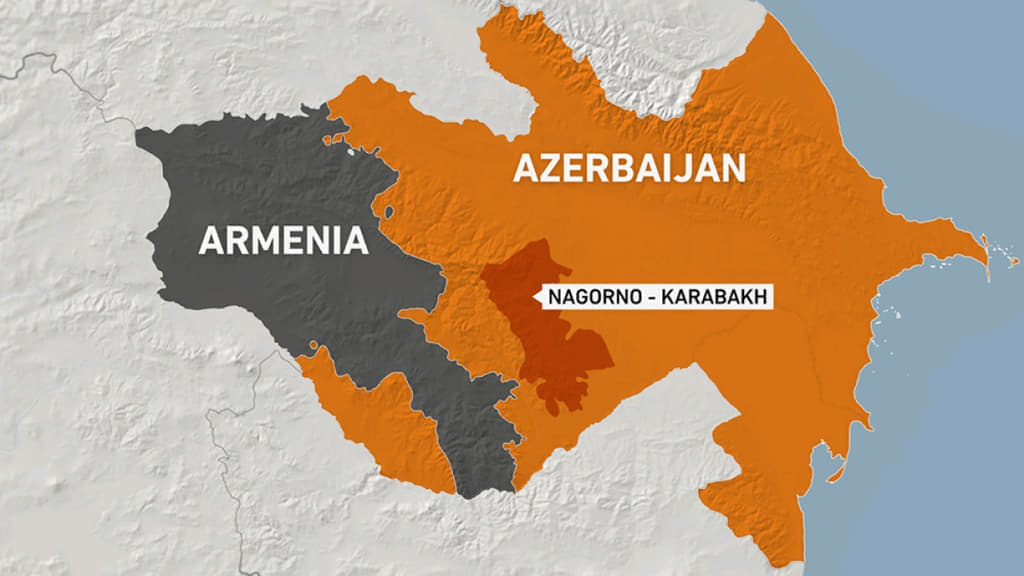Good books are rare, and clear, concise works are even rarer. Jean-Marie Lorgé’s Les guerres du Haut Karabakh (éditions Baudelaire, 2021) has both these qualities. It should be published in English.
To understand this tragic conflict, you need to know Erdogan’s vision of the international chessboard (or his geopolitical vision, if you prefer) as the author describes it. And we can trust him.
Erdogan anchors Turkey on two pillars: the “Blue Homeland” and “Pan-Turkism.” The “Blue Homeland” is a kind of bread-and-butter patriotism aimed at taking control of the southern and eastern Mediterranean Sea and its resources. This should put Europe on its guard. The counterpart to this “Blue Homeland” is the realization of Enver Pasha’s grand design: the coalition of Turkish-speaking regions from the Bosphorus to the Altai Mountains, under Turkish leadership. Azerbaijan, the Muslim-majority country ethnically, culturally and linguistically closest to Turkey, is the second link in this Pontic chain: from Turkey to Kirghizia, via Azerbaijan, Turkmenia, Kazakhstan and Uzbekistan. The first Nagorno-Karabakh war (1990) pitted it against Azerbaijan. The second war (2020) brought Turkey into the picture. Its unwavering support for Azerbaijan is in line with Ankara’s policy. Added to this, and no one dares say it, is Islam’s age-old hatred of Christians. And on this point, Turkey has shown throughout history that this hatred has gone as far as genocide, not only of Armenians but also of Aramaic-speaking Christian populations. The press calls it ethnic cleansing, but religious cleansing too.
In September-November 2020, the immediate aim of the Azerbaijani “steel fist” offensive was to break the Shushi lock, to block the Lachin corridor (10 km long) through which the only road linking Karabakh to Armenia passes, and to cut off the second road linking two Armenian towns. In other words, the aim was to suffocate Nagorno Karabakh. The defeat, both military and political, was total. Armenia was left with the choice of either toning down its desire for Westernization and accepting closer political and military relations with Russia, Iran and China, or accepting the path outlined by Erdogan on December 10, 2020 at the Victory Parade in Baku”: vassal status within a regional coalition dominated by a Turkey drunk with its Ottoman past. And we know all about the Ottoman past: from Islamic oppression to massacres and genocide.
There remained a third way: to start a desperate war all over again. That’s what we’ve seen recently. With a new debacle. The second war was part of Erdogan’s vision of a Bosphorus/Altai territorial continuum, of which the Turkey/Azerbaijan territorial continuity was the first step. To achieve this, the Nagorno Karabagh lock had to be broken.
And that’s now done. There’s still one more lock: Siunik, which has been Armenian for two millennia, and which the Azeris also claim, but taking the 19th and 20th centuries as their starting point; that is, when their state was born. Before that, there is no history of Azerbaijan comparable to the long and dramatic history of Armenia or Georgia. The Azeris can therefore make no claim before the last three centuries. The capture of central and southern Siunik by Turkey, through Azerbaijan, would see the realization of Pan-Turkism’s major political objective: a Turko-Azerbaijani mass (Muslim and hardline), with three maritime windows.
Once Turkey joined Europe, we can imagine the consequences. The third Nagorno-Karabakh war did indeed take place. But not the one we might have expected. Which may mean that it’s not over yet. On the territories recovered by Azerbaijan under the terms of the November 9, 2020 agreement, some 80 Christian religious buildings have been destroyed.
Marion Duvauchel is a historian of religions and holds a PhD in philosophy. She has published widely, and has taught in various places, including France, Morocco, Qatar, and Cambodia. She is the founder of the Pteah Barang, in Cambodia.
